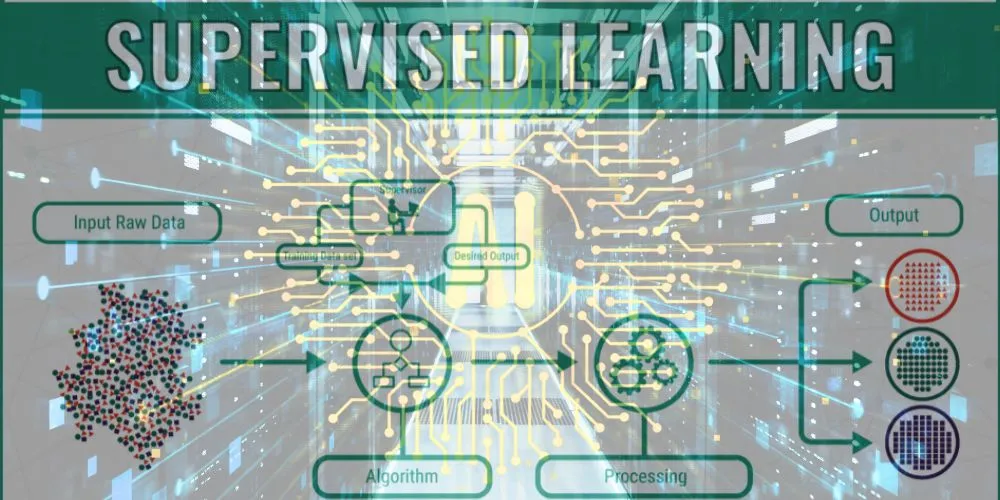Supervised learning is a cornerstone in machine learning, providing a guided approach where models learn from labeled datasets to make predictions or classifications. This article will delve into the fundamental principles, diverse methodologies, key advantages, notable applications, and challenges associated with supervised learning, showcasing its pivotal role in harnessing data for precision and prediction.
Unveiling Supervised Learning
Supervised learning, at its core, involves training machine learning models using labeled datasets. The ‘supervision’ comes from explicit labels associated with each data point, enabling the algorithm to learn patterns and relationships between input features and corresponding output labels. This guided learning process empowers models to predict new, unseen data accurately.
Core Components of Supervised Learning
The fundamental components of supervised learning encompass input features, output labels, a model, and a loss function. Input features serve as the information provided to the model, while output labels are the desired predictions. The model learns from the training data by minimizing a defined loss function and quantifying the difference between predicted outputs and actual labels.
Classification and Regression
Supervised learning encompasses two primary tasks: classification and regression. The model predicts discrete labels in classification, assigning input data points to predefined categories. On the other hand, regression involves predicting continuous values, such as numerical quantities. These tasks cater to many real-world problems, from image classification to predicting stock prices.
Supervised Learning Algorithms
Several algorithms exist within supervised learning, each tailored to specific tasks and data characteristics. Notable algorithms include linear regression for regression tasks, decision trees for classification and regression, and support vector machines (SVM) for efficient classification in high-dimensional spaces.
Training Supervised Learning Models
The training process in supervised learning involves feeding the model labeled data, allowing it to adjust its parameters iteratively. The model’s performance is evaluated using a validation set, and adjustments are made to optimize its predictive capabilities. The ultimate goal is to make a model that generalizes well to new, unseen data, making accurate predictions beyond the training dataset.
Overfitting and Underfitting
Two common challenges in supervised learning are overfitting and underfitting. Overfitting occurs when a model learns the training data too well, capturing noise and performing poorly on new data. In contrast, underfitting happens when a model is too simplistic and fails to capture the underlying patterns in the data. Balancing these concerns is crucial for achieving a well-generalized model.
Hyperparameter Tuning
Supervised learning models often involve hyperparameters, which are parameters that govern the learning process. Tuning these hyperparameters is essential to optimize the model’s performance. Techniques such as grid or randomized search are employed to find the optimal combination of hyperparameter values, enhancing the model’s predictive accuracy.
Cross-Validation
Cross-validation is a robust technique in supervised learning for assessing a model’s performance. It involves splitting the dataset into multiple subsets, training the model on different subsets, and evaluating its performance on the remaining data. It helps ensure the model’s performance is consistent across various data partitions.
Advantages of Supervised Learning
Supervised learning offers numerous advantages, making it a widely adopted approach in machine learning applications. The explicit guidance labeled data provides enables models to learn complex patterns and relationships. The ability to make predictions on new, unseen data is a key strength, making supervised learning suitable for tasks ranging from image recognition to natural language processing.
Precision and Accuracy
Supervised learning models strive for precision and accuracy in their predictions. The explicit supervision allows models to learn intricate patterns, making highly accurate predictions. It is especially crucial in applications where precision is paramount, such as medical diagnosis or autonomous vehicle navigation.
Versatility in Applications
The versatility of supervised learning is evident in its applications across diverse domains. In healthcare, it aids in disease diagnosis; in finance, it facilitates credit scoring; and in marketing, it optimizes customer segmentation. The adaptability of supervised learning makes it a go-to choice for addressing many real-world challenges.
Rapid Decision-Making
Supervised learning models enable rapid decision-making by leveraging the learned patterns from historical data. Supervised learning proves invaluable in scenarios where timely and accurate predictions are crucial, such as fraud detection in financial transactions or manufacturing predictive maintenance.
Applications of Supervised Learning
Supervised learning applications span a wide spectrum, demonstrating their effectiveness in solving complex problems across various domains.
Healthcare Diagnosis and Prognosis
In healthcare, supervised learning contributes significantly to diagnostic models. By training on labeled medical datasets, models can learn to identify disease-associated patterns, aiding in early diagnosis and prognosis.
Natural Language Processing
Supervised learning is pivotal in natural language processing tasks, including sentiment analysis, text classification, and machine translation. Labeled text data empowers models to understand and generate human-like language.
Autonomous Vehicles
In the realm of autonomous vehicles, supervised learning is instrumental. Models trained on labeled datasets of road scenes learn to recognize and respond to various traffic scenarios, enhancing the safety and reliability of self-driving cars.
Financial Fraud Detection
Supervised learning is a key player in detecting fraudulent activities in financial transactions. By learning from labeled data, models can identify patterns indicative of fraudulent behavior, protecting financial systems and users.
Challenges in Supervised Learning
While supervised learning offers powerful solutions, it is not without challenges. Addressing these challenges is critical for advancing the capabilities of supervised learning models.
Data Quality and Bias
The quality of labeled data is paramount in supervised learning. Biases present in the training data can lead to biased models. Ensuring diverse and representative datasets is essential to mitigate biases and enhance the fairness of supervised learning models.
Data Annotation Costs
Labeling large datasets for supervised learning can be a resource-intensive process. The cost associated with manual data annotation or the need for expert knowledge in certain domains can pose challenges, especially in applications with limited labeled data.
Generalization to Unseen Data
The ability of supervised learning models to generalize to new, unseen data is critical. Ensuring that models do not overfit the training data and can handle variations in real-world scenarios is an ongoing challenge.
Future Trends in Supervised Learning
Supervised learning adapts to emerging trends as machine learning evolves, enhancing its capabilities.
Transfer Learning
Transfer learning is a growing trend in supervised learning, allowing models trained on one task to be repurposed for another related task. This approach leverages pre-trained models to improve performance, especially in scenarios with limited labeled data.
Explainable AI
Explainability is gaining prominence in supervised learning, especially in applications where understanding model decisions is crucial. Enhancing the interpretability of models fosters trust and facilitates their deployment in sensitive domains such as healthcare and finance.
Integration with Deep Learning
The integration of supervised learning with deep learning represents a promising trend. Deep neural networks, with their capability to learn hierarchical representations, enhance the capabilities of supervised learning models, leading to improved performance in tasks like image recognition and speech processing.
Conclusion
Supervised learning stands as a linchpin in machine learning, offering a guided path for models to learn from labeled data and create accurate predictions. Its precision, versatility, and wide-ranging applications make it an indispensable tool across various industries. While challenges persist, ongoing advancements and future trends indicate a robust future for supervised learning, solidifying its role in shaping the landscape of intelligent systems.”










